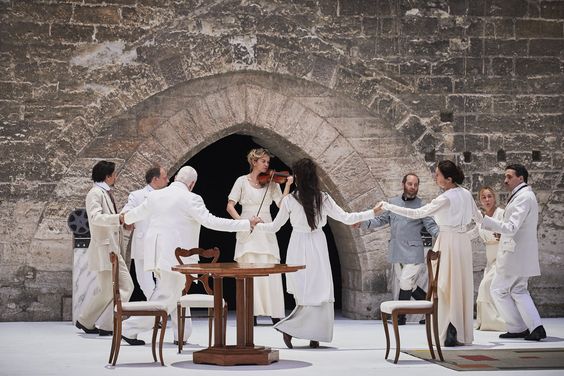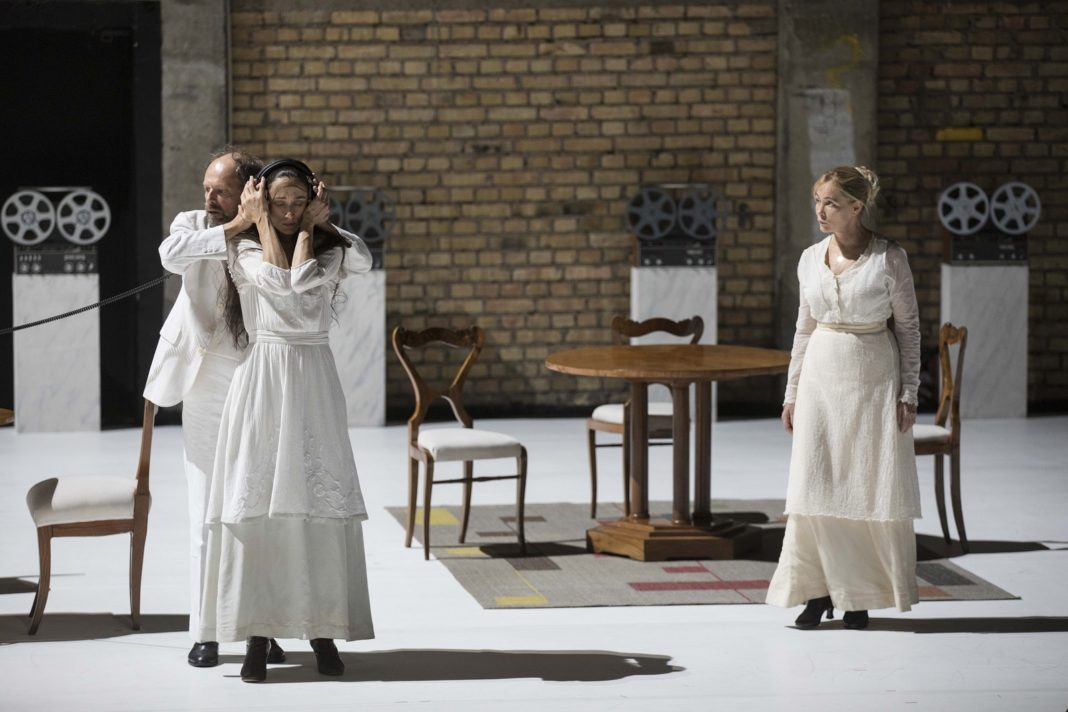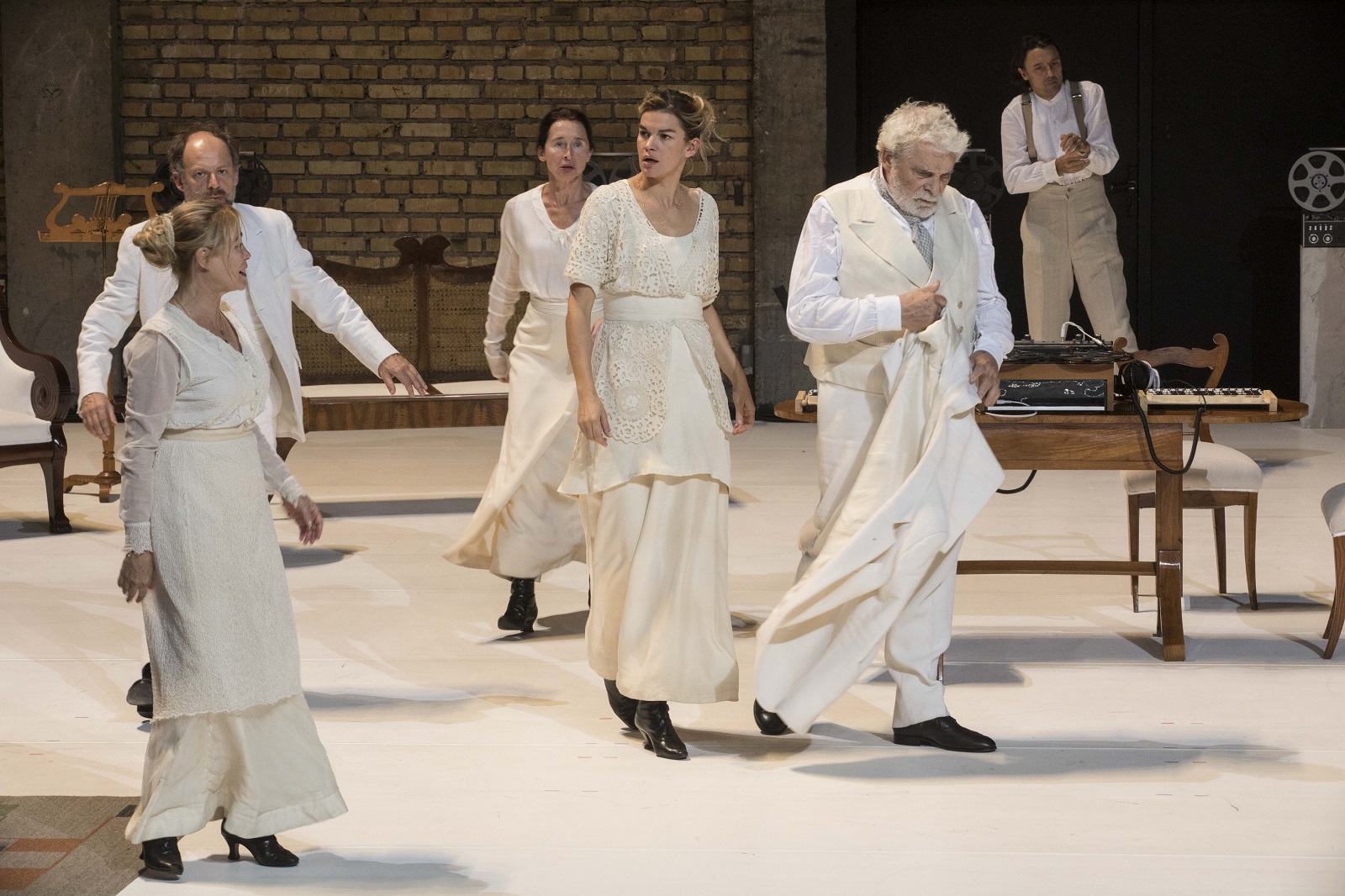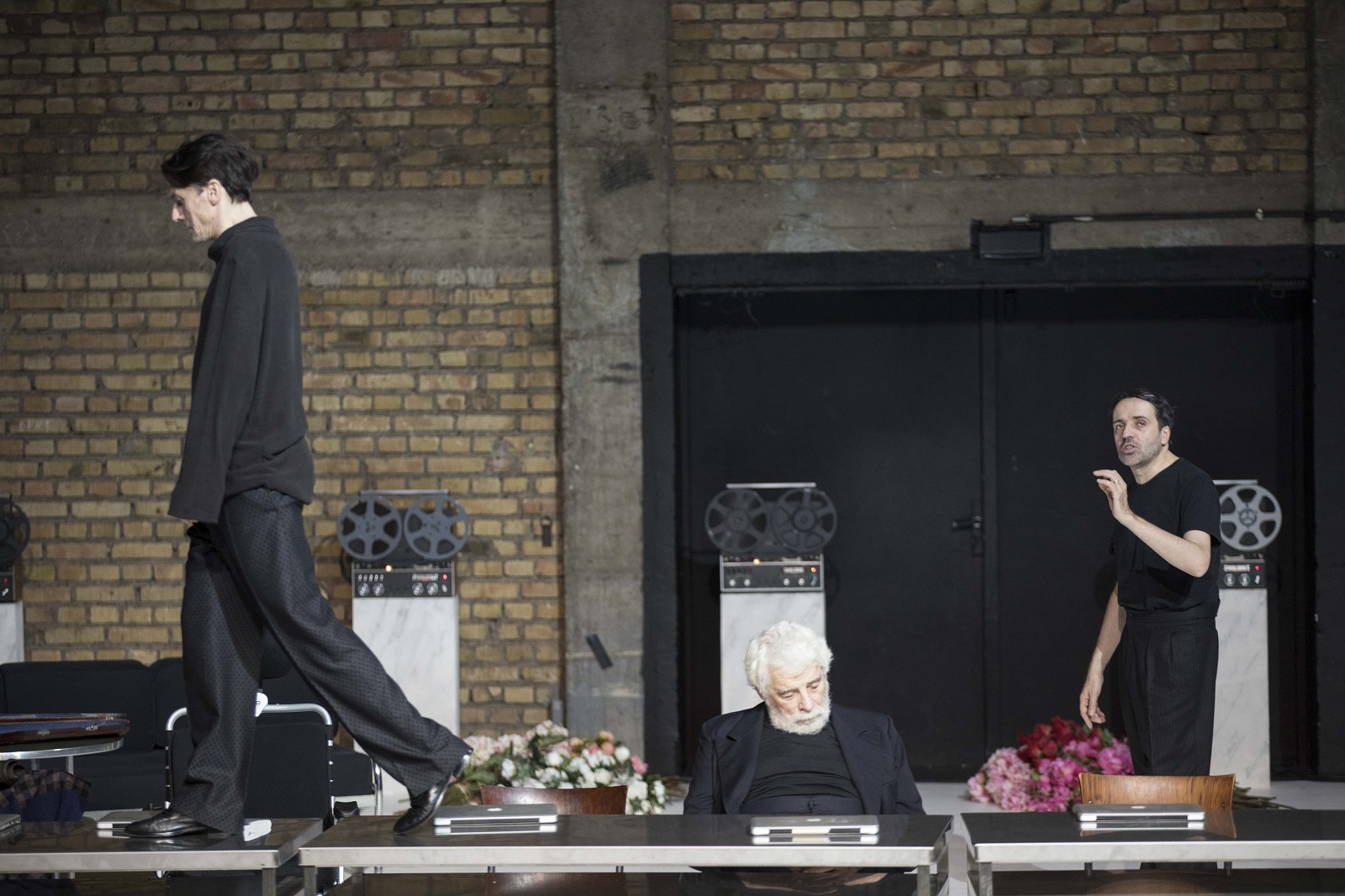ANDREA ZANGARI | Architecture in tre parole: parole, parole, parole. Tre ore grondanti parole, un fiume per salvarsi dal fiume d’informazioni che imperversa nel mentre e che rischia di annegare il teatro. E che, in effetti, ha messo fine prematura a questa edizione di VIE Festival 2020, interrotto per la famigerata ordinanza regionale al termine del primo weekend. Si sta seduti in platea con un senso di irrequietezza, che non è paura del contagio possibile, ma contaminazione di fatto della propria capacità di ascolto. Non distrazione, ma disagio della durata, difficoltà a ritagliare per la drammaturgia il suo tempo. Il pubblico che si prepara alla visione non sa parlare d’altro. Eppure, Pascal Rambert, regista e autore del testo, sfida il pubblico con la consueta, virulenta intensità. Il palco dell’Arena del Sole si mostra spogliato in tutta la sua altezza e profondità, fino all’uscita di emergenza che dona un punto di fuga mentale e visivo alla prospettiva scenica. Niente cielo, quinte, fondale. Schiacciato dall’altezza dell’arcoscenico, un salotto fin de siècle è elencato dall’elegante mobilio in legno, sotto la luce a giorno di Yves Godin. L’allestimento è reminiscenza di un altro luogo: riporta alla prima di Architecture nella Cour d’honneur del Palazzo dei Papi di Avignone (luglio 2019). Uno spazio, quello avignonese, magnifico nella sua nudità, per il quale Rambert ha affermato di aver rimesso mano al soggetto stesso, iniziato nel 2018. Se d’architettura si tratta, d’altro canto, non poteva che agire in trasparenza la scenografia: basta dire lo spazio, svelarne struttura e funzione, metterlo a disposizione degli attori. Per Rambert, del resto, il teatro è sempre agone della parola, per un pubblico intronizzato oltre l’irremovibile quarta parete.

In tal senso, Architecture è una tragedia classica, sino alle estreme conseguenze: la parola veicola l’azione, la descrive, la sublima, la supera, fino all’ auto-delirio di onnipotenza del linguaggio, portando gli attori al parossismo fatico. A scanso di equivoci, la prima scena scorre d’un fiato nell’arco di una sola battuta, quella di Jaques, il capofamiglia, l’architetto. La sua parola è principio e motore del dramma, e ricapitola l’antefatto: ad una cerimonia governativa in suo onore, il figlio Stan ha interrotto l’orazione con versi scimmieschi. Il lungo, quasi estenuante j’accuse è rivolto in prima persona al figlio colpevole, ma alla presenza dell’intera famiglia, ovvero dell’altro figlio, Pascal, e delle due figlie Anne ed Emmanuelle, tutti e tutte accompagnate dai propri partner (rispettivamente Audrey, Laurent, Arthur) fatto salvo il reo Stan. Siamo a Vienna, nei primi anni del Novecento, e da lì questa famiglia allargata, invariabilmente compresente sulla scena (d’altro canto, si è detto, le quinte sono scomparse), inizia un viaggio verso sud: Bratislava, i Balcani, la Grecia, i fregi del Partenone, il tempio di Apollo, poi Skopje e la guerra, i suoi massacri. Movimenti sempre e solo descritti, veicolati dalla parola nel parallelo intreccio fra personaggi.
Architecture è dunque metafora dell’Occidente che si avvia al tramonto risalendo verso l’oriente delle sue origini, verso la luce estrema dell’Acropoli ateniese, abbacinante lucore marmoreo di un inizio. ‘Architettura’, d’altro canto, contiene archè, principio di tutte le cose, e tèkton, la tecnica, orizzonte immutabile del nostro tempo. Architettura è dunque utopia circolare, equilibrio tra il fare umano e il principio che regola quel fare. Ma, in quanto utopia, essa è irrealizzabile: così Jacques, l’architetto, è un dio-padre tragico, in conflitto costante con una progenie disorientata dal suo divino dispotismo. Architectus secundus deus, dicevano i latini. Rambert usa e sviluppa questa tensione edipica lungo due traiettorie: una archetipica, che eleva il dramma e i personaggi a evidenze simboliche, ed una quotidiana, che radica la scrittura nella schermaglia famigliare fra padri e figli, mariti e mogli, fratelli e sorelle. Operazione complessa che, giocoforza, si misura con la sua ambizione: rispetto a drammi più lineari come Cloture de l’amour, Prova, L’arte del teatro, la struttura dialogica combina varie micro-drammaturgie. Conseguentemente, la tessitura drammaturgica è binaria, ogni scambio di battute inscrivendosi in un plot corale, così come sdoppiata deve essere l’attenzione di chi guarda. La regia si manifesta in una certosina triangolazione degli sguardi e delle pose, a servizio di un montaggio che inquadra, di volta in volta e a velocità variabile, cambi di focus da un dialogo all’altro.
Ulteriore difficoltà per il pubblico non francofono dell’Arena del Sole è portare lo sguardo ai sopratitoli, peraltro privi di punteggiatura come la scrittura fluida di Rambert pretende (eppure, il sopratitolo non è il testo: dovrebbe riflettere la partitura scenica che, di fatto, una punteggiatura ce l’ha). Davvero un cimento eccessivo, soprattutto se protratto lungo più di tre ore di spettacolo. D’altro canto, la qualità attoriale è immensa e facilita il compito: Emmanuelle Béart, Audrey Bonnet, Anne Brochet, Marie-Sophie Ferdane, Arthur Nauzyciel, Stanislas Nordey, Pascal Rénéric, Laurent Poitrenaux e Jacques Weber compongono un cast che non ha bisogno di plausi aggiuntivi. Sono attori che da anni collaborano con Rambert, inducendoci per altro a constatare come, oltralpe, la contaminazione fra lo star system (anche) cinematografico e il teatro, per così dire, d’arte, sia ben più frequente che in Italia. Scorrendo le pagine del testo tradotto (a cura di Chiara Elefante, Luca Sossella Editore) appare chiaro come questo monumentale canto renda necessarie doti interpretative non comuni. Più che un testo, si tratta di una partitura orchestrale, non a caso ritmata in scena da una sequenza di “accordo” all’inizio di ciascuna delle tre parti, un accenno di ballo con tutti i personaggi in cerchio intorno a Marie-Sophie, giovane fidanzata di Jacques subentrata a una moglie defunta, che dà il la con il suo violino.
La musica è infatti presenza decisiva, su un piano simbolico e drammaturgico, quanto e più dell’architettura. Pascal e la moglie Audrey sono musicisti, sperimentatori d’inizio secolo à la Schönberg, riferimento ovviamente non casuale alla Scuola Viennese. Siamo in un momento storico di rottura fra l’ancien regime artistico e culturale, che ha in Jaques la sua metafora accademica, e la prima avanguardia novecentesca. La diatriba padre-figlio assume così i toni della disfida estetica, ricalca la dialettica sovrastorica conservazione-innovazione, che proprio nella mittleuropa produsse le conquiste artistiche e filosofiche più determinanti dell’epoca. La famiglia in scena è dunque metafora di un continente che, all’apogeo, si perse nel suo riflesso, disvelando i propri fantasmi attraverso la psicanalisi (il personaggio di Emmanuelle fa la psicologa). La guerra è il punto di caduta di tanta vertigine. Ma la guerra storica è, per Rambert, cortocircuito di una cultura, crisi del linguaggio. È la stessa guerra che si combatte, per esempio, nella coppia di Cloture de l’amour, ma più radicale, capillarmente risalita nella fibra di tutte le relazioni. La lingua umana si è innalzata a tal punto da congedarsi dalle cose e dai corpi che la producono, tanto che solo la voce resta oltre i corpi smembrati sul campo di battaglia: «la mia voce è qui il mio corpo non è affatto qui è tutto smembrato sono chiaramente smembrata mi sentite no forse sto già parlando dal fondo delle cisterne sono in una cisterna che ha pareti alte e voi non mi sentite devo essere uscita dal corpo» dice Emmanuelle, dando misura della forza autodistruttiva che impenna nella terza e ultima parte del dramma. Jouir des mots, mourir des mots. I corpi diventano corpi-senza-organi, i personaggi prendono ad elencare la propria dissoluzione, una teoria di immagini tra il macabro e il surreale. Al contempo, la tensione dialogica sfuma nel delirio monologante. Restano le voci, imprigionate nei Revox allineati a fondo palco, con le bobine che ricordano le volute dei capitelli ionici.
La drammaturgia procede per accumulo, una serie di falsi finali si affastella nella mente dello spettatore, in forza del pensiero che lo smembramento non possa proseguire oltre. Eppure, Architecture prosegue. Il mobilio Biedermeier lascia posto a tubolari in acciaio stile Bauhaus, approntati a vista da tecnici in camice blu. I costumi di lino della prima parte, candidi come i marmi dell’acropoli, vengono dismessi per vestire panni colorati anni ’60, infine un moderno outfit total black; l’architettura ornata è invece sostituita dall’estetica funzionalista: tèkton abbandona arché, come la voce i corpi. Si giunge a fare l’amore con le sole parole, fra il corpo troppo anziano di Jaques e quello, diventato invalido, di Marie-Sophie. La guerra è finita, un’altra sta per iniziare, quella delle parole ha portato i personaggi al limite dell’esistenza. Non c’è tempo che per risvegliarsi nell’oggi, annunciato dalla mela luminosa dei portatili su cui gli attori si scrivono il copione. Qui diventa chiaro anche ai più distratti che, come in altri lavori di Rambert, i nomi dei personaggi sono quelli degli attori. Emmanuelle, Audrey, Anne, Marie-Sophie, Arthur, Stanislas, Pascal, Laurent e Jacques parlano dei loro personaggi come di avi per cui inventare una fine. La descrivono, la provano, la discutono, come personaggi dei personaggi. Sul finire la scrittura si fa analitica, abbandona il magma poetico che spesso virava in accenti affettati e declamatori.
Si è ormai compreso come ad Architecture difetti la misura (è proprio la tragedia della perdita della misura), nel tentativo di cogliere, con indubbia efficacia lirica e stupefacente intensità attorica, l’intera parabola di un’Europa che si interroga di nuovo sui suoi fallimenti e i rischi che ne conseguono. Rambert traccia la strada verso l’inferno, ma ci offre anche una via d’uscita. È infatti lì, a fondo palco, l’uscita di sicurezza in bella vista. Ma certo non ci stupiremmo se qualche spettatore si sia fermato prima, per le ferite dell’ascolto. O trascinato via dalle preoccupazioni, più o meno concrete, che riempiono la città oltre quell’uscita di (in)sicurezza.
English translation
Architecture, in three words: words, words, words. A three-hours river of words to save ourself from the river of information that rages in the meantime and which risks to drown the theater. And that, in fact, prematurely put an end to this edition of Vie Festival, interrupted by the notorious regional ordinance at the end of the first weekend. The audience is settled with a sense of restlessness, which is not a fear of possible contagion, but a de facto contamination of one’s listening ability. Not distraction, but lasting discomfort, difficulty in dedicating to dramaturgy its own time. The public preparing for the vision cannot speak of anything else. Yet Pascal Rambert, director and author of the text, challenges the public with the usual, virulent intensity. The stage of the Arena del Sole shows itself stripped in all its height and depth, up to the emergency exit that gives the scenic perspective a mental as well as visual point of escape. No sky, nor backstage or backdrop. Crushed by the height of the arch, a fin de siècle lounge is listed by the elegant wooden furniture, under a day light designed by Yves Godin. The setting is reminiscent of another place: it takes memory back to the premiere of Architecture in the Cour d’honneur of the Palazzo dei Papi in Avignon (July 2019). A space, the Avignonese one, magnificent in its purity, for which Rambert claimed to have put his hand back on the play subject. Since we deal with architecture, scenography could only work transparently: just to say the space, to reveal its structure and function, making it available to the actors. For Rambert, in fact, theater is always a word device, for an audience enthroned beyond the immovable fourth wall.
In this sense, Architecture is a classic tragedy, to the extreme consequences: the word conveys the action, describes it, sublimates it, overcomes it, up to the self-delusion of omnipotence of language, leading the actors to a literal paroxysm. It is not surprising that the first scene flows in a single breath, that of Jaques, the head of the family, the architect. His word is the principle and engine of the drama. It summarizes the premise: for the occasione of a governmental ceremony in his honor, his son Stan interrupted the prayer with apes. The long, almost exhausting j’accuse is addressed to the guilty son, but in the presence of the whole family, composed by the other son, Pascal, and the two daughters Anne and Emmanuelle, all accompanied by their partners (respectively Audrey, Laurent, Arthur) except the offender Stan. We are in Vienna, in the early twentieth century, and from there this extended family, invariably present on the scene (on the other hand, it has been said, the backscenes have disappeared), begins a journey towards the south: Bratislava, the Balkans, Greece , the friezes of the Parthenon, the temple of Apollo, till Skopje and the war, its massacres. These movements are always only described, conveyed by the word in the parallel interweaving amid characters.
Architecture is therefore a metaphor for the West which sets off at sunset going up towards the east of its origins, towards the extreme light of the Athenian Acropolis, the dazzling marble glow of the beginning. Architecture, on the other hand, etymologically contains archè, the principle of all things, and tèkton, the technique, the immutable horizon of our time. Architecture is therefore a circular utopia, a balance between human doing and the principle that regulates that doing. But, as a utopia, it is unachievable: thus Jacques, the architect, is a tragic father-god, in constant conflict with a progeny disoriented by his divine despotism. Architectus secundus deus, the Latins said. Rambert develops this oedipal tension along two trajectories: an archetypal one, which elevates the drama and the characters to symbolic evidences, and a daily one, which roots in the family skirmish between fathers and sons, husbands and wives, brothers and sisters. A complex operation that hits against its ambition: compared to more linear dramas such as Cloture de l’amour, Rehearsal, The art of theater, the dialogical structure combines various micro-dramaturgies. Consequently, the dramaturgical texture is binary, each exchange of lines inscribing themselves in a choral plot, as well as double must be the attention of the beholder. The direction is manifested in a painstaking triangulation of the looks and poses, at the service of a montage that frames, at variable speed, changes of focus from one dialogue to another.
A further difficulty for the non-French-speaking public of the Arena del Sole is to check the surtitles, which are not punctuated as the fluid writing of Rambert claims (yet, the surtitle is not the text: it should reflect the scenic score which, in fact, has a precise punctuation). Really an excessive trial, especially if it has lasted more than three hours of entertainment. On the other hand, the actor’s quality is immense and facilitates the task: Emmanuelle Béart, Audrey Bonnet, Anne Brochet, Marie-Sophie Ferdane, Arthur Nauzyciel, Stanislas Nordey, Pascal Rénéric, Laurent Poitrenaux and Jacques Weber compose a cast that doesn’t need of additional plaudits. They are actors who have been collaborating with Rambert for years, further inducing us to note how, beyond the Alps, the contamination between the (also) cinematographic star system and the theater, so to speak, of art, is much more frequent than in Italy. Scrolling through the pages of the translated text (edited by Chiara Elefante, Luca Sossella Editore) it is clear how this monumental song makes uncommon interpretative skills necessary. More than a text, it is an orchestral score, not surprisingly punctuated on stage by a sequence of “chord” at the beginning of each of the three parts, a hint of dance in a circle with all the characters around Marie-Sophie, Jacques’ young girlfriend who took over from a deceased wife, who gives a go with her violin.
Music is in fact a decisive presence, on a symbolic and dramaturgical level, as much and more than architecture. Pascal and his wife Audrey are musicians, early-century experimenters à la Schönberg, not a casual reference to the Viennese School. We are in a historical moment of break between the artistic and cultural ancien regime, which has its academic metaphor in Jaques, and the first twentieth-century avant-garde. The father-son diatribe thus takes on the tones of the aesthetic challenge, follows that superhistorical conservation-innovation dialectic which produced the most decisive artistic and philosophical achievements of the time in mittleurope. The family on stage is therefore the metaphor of a continent which, at its apogee, got lost in its reflection, revealing its ghosts through psychoanalysis (Emmanuelle’s character is a psychologist). War is the point of fall of such vertigo. But historical war is, for Rambert, a short circuit of a culture, a crisis of language. It is the same war that is fought, for example, in the couple of Cloture de l’amour, but more radical, capillary rising in the fiber of all relationships. The human tongue has risen to the point of taking leave of the things and bodies that produce it, so much that only the voice remains beyond the dismembered bodies on the battlefield. Jouir des mots, mourir des mots. Bodies become bodies-without-organs, the characters begin to list their dissolution, a theory of images between the macabre and the surreal. At the same time, the dialogical tension fades into the monologuing delirium. The voices remain, imprisoned in the Revox lined up at the bottom of the stage, with the reels reminiscent of the Ionic swirls.
The dramaturgy proceeds by accumulation, a series of false endings bundles in the mind of the spectator, by virtue of the thought that the dismemberment cannot continue further. Still, Architecture continues. The Biedermeier furniture gives way to Bauhaus-style steel tubulars, prepared on sight by technicians in blue shirts. The linen costumes of the first part, white like the marbles of the acropolis, are discarded to wear coloured 1960s cloths, and eventually a modern total black outfit; architecture of ornament is instead replaced by functionalist aesthetics: tèkton abandons archè, like voice abandons bodies. We get to the point love is made with words alone, between Jaques’ too old body and Marie-Sophie’s become disabled. The war is over, another is about to begin, that of words has brought the characters to the limit of existence. There is no time but to wake up in the current time, as announced by the bright apple of the laptops on which the actors write their own script. Here it becomes clear even to the most distracted that, as in other Rambert’s works, the names of the characters are those of the actors. Emmanuelle, Audrey, Anne, Marie-Sophie, Arthur, Stanislas, Pascal, Laurent and Jacques speak of their characters as ancestors for whom to invent an end. They describe it, try it, discuss it, as characters of the characters. At the end, the writing becomes analytical, it leaves the poetic magma that often veered in sliced and declamatory accents.
It has now been understood how Architecture defects the measure (it is precisely the tragedy of the loss of the measure), in an attempt to capture, with undoubted lyrical efficacy and astonishing actor intensity, the whole parable of a Europe that questions itself once again about its failure. Rambert traces the road to hell, but also offers us a way out. In fact, there is the emergency exit at the end of the stage.
ARCHITECTURE
testo, ideazione, installazione Pascal Rambert
con Emmanuelle Béart, Audrey Bonnet, Anne Brochet, Marie-Sophie Ferdane, Arthur Nauzyciel, Stanislas Nordey, Pascal Rénéric, Laurent Poitrenaux, Jacques Weber e Césarée Genet Bonnet in alternanza con Rose Poitrenaux
traduzione Chiara Elefante
luci Yves Godin
costumi Anaïs Romand
musica Alexandre Meyer
Creato il 04 luglio 2019 nella Cour d’Honneur del Palais des Papes, Festival di Avignone
Prima nazionale a VIE Festival 2020, 22-23 febbraio, Arena del Sole, Bologna






